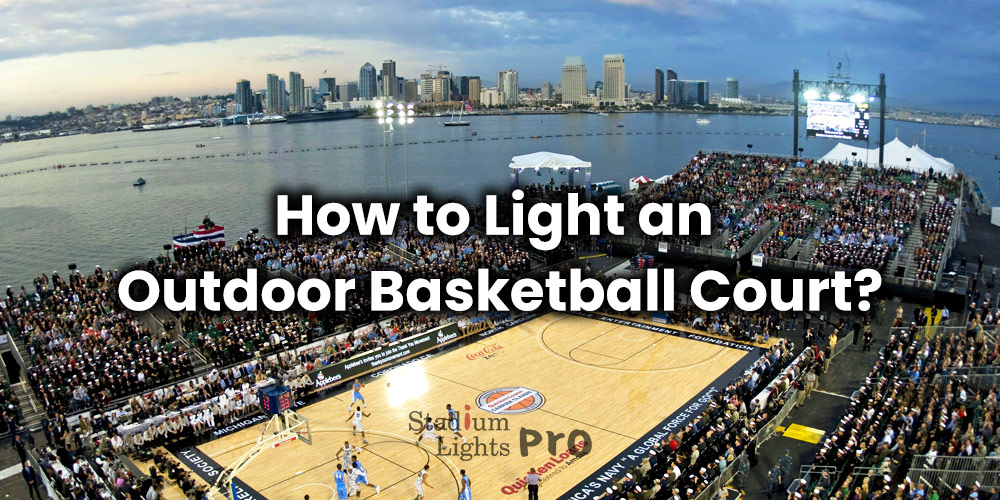Proper lighting plays a crucial role in creating a safe and enjoyable environment for outdoor basketball courts. Well-lit courts offer a range of benefits, including enhanced safety for players and spectators, as well as improved visibility and gameplay.
Table of Contents
ToggleAssessing the lighting requirements
Determine the size and dimensions of the basketball court
To determine the size and dimensions of a basketball court, you can follow the standard measurements outlined by various governing bodies such as FIBA (International Basketball Federation) or the NBA (National Basketball Association). The dimensions for a regulation-sized basketball court are as follows:
- Length – The standard length of a basketball court is 94 feet (28.65 meters) for both professional and college-level games.
- Width – The standard width of a basketball court is 50 feet (15.24 meters) for both professional and college-level games.
- Three-point line – The three-point line forms an arc at a specific distance from the basket. In the NBA, the arc’s radius is 23 feet, 9 inches (7.24 meters) at the top of the arc and gradually decreases to a minimum of 22 feet (6.71 meters) in the corners. For FIBA, the arc’s radius is 6.75 meters.
- Key area – The key, also known as the paint or the lane, is the rectangular area under the basket. In the NBA, it is 16 feet (4.88 meters) wide, while in FIBA, it is slightly wider at 16.5 feet (5 meters). The key extends 15 feet (4.57 meters) from the baseline to the free-throw line.
- Free-throw line – The free-throw line is located 15 feet (4.57 meters) from the backboard and is used for free-throw shots.
Consider the level of play and the associated lighting standards
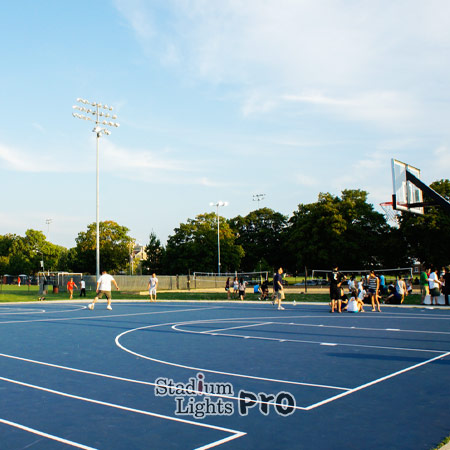 When considering the level of play for an outdoor basketball court and the associated lighting standards, the required illuminance levels are typically measured in lux (lx) or footcandles (fc). The recommended lighting levels may vary based on the level of play. Here are the general lighting recommendations for different levels:
When considering the level of play for an outdoor basketball court and the associated lighting standards, the required illuminance levels are typically measured in lux (lx) or footcandles (fc). The recommended lighting levels may vary based on the level of play. Here are the general lighting recommendations for different levels:
Recreational level
For recreational-level basketball courts, the recommended lighting levels typically range from 50 to 150 lux (5 to 15 fc). These lower lighting levels are suitable for casual play, ensuring basic visibility and safety.
Amateur level
Amateur-level basketball courts, such as community or school courts, generally require higher lighting levels compared to recreational courts. The recommended lighting levels for amateur-level courts typically range from 150 to 250 lux (15 to 25 fc). These increased lighting levels provide better visibility for players and improve gameplay accuracy.
Professional level
Professional-level basketball courts require the highest lighting standards to meet the rigorous demands of competitive play. The recommended lighting levels for professional-level courts generally range from 250 to 500 lux (25 to 50 fc) or more. These higher lighting levels ensure excellent visibility, minimal shadows, and optimal conditions for top-tier performance.
Evaluate local regulations and guidelines for outdoor sports facilities lighting
When evaluating local regulations and guidelines for outdoor sports facilities lighting, we may consider the specific requirements and restrictions imposed by local authorities or governing bodies. Here are some key aspects to assess:
Zoning and permitting
Research the zoning regulations and permits required for installing or modifying lighting systems in outdoor sports facilities. Understand any restrictions on lighting height, placement, or intensity that may be imposed by local zoning ordinances.
Light pollution and glare control
Some areas have regulations in place to mitigate light pollution and minimize the impact of artificial lighting on the surrounding environment. Assess whether there are any restrictions on light trespass, glare, or upward light spill that may affect the design and installation of the lighting system.
Energy efficiency
Many regions have energy efficiency standards and requirements for outdoor lighting. Evaluate if there are specific regulations that promote the use of energy-efficient lighting technologies or require compliance with certain efficiency standards.
Dark sky compliance
Some areas adhere to dark sky principles, aiming to reduce light pollution and preserve the natural night sky. Determine if there are regulations or guidelines regarding dark sky compliance and the use of specific lighting fixtures or shielding techniques.
Environmental considerations
Certain regions may have regulations or guidelines focused on protecting local flora and fauna from the effects of lighting. Assess if there are any requirements for minimizing the impact of lighting on wildlife habitats or migratory patterns.
Safety and electrical codes
Ensure compliance with local safety and electrical codes to guarantee the installation meets the necessary standards for electrical wiring, grounding, and overall safety.
Choosing the right lighting system
Different types of lighting systems available
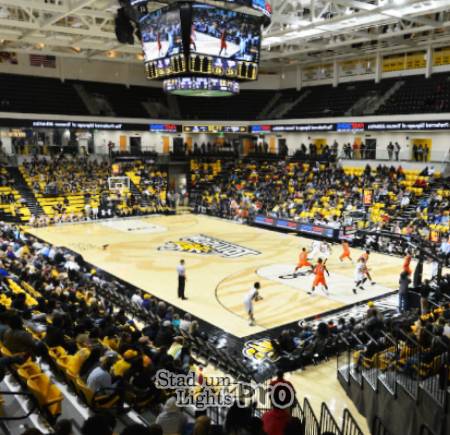 When it comes to lighting outdoor basketball courts, there are various types of lighting systems available, each with its own advantages and considerations. Here are some commonly used lighting technologies:
When it comes to lighting outdoor basketball courts, there are various types of lighting systems available, each with its own advantages and considerations. Here are some commonly used lighting technologies:
Metal Halide (MH) lighting
Metal halide lamps have been a popular choice for outdoor sports lighting due to their bright output and good color rendering. They provide high-intensity lighting, making them suitable for professional-level courts. Metal halide lamps have a relatively long lifespan but require a warm-up time to reach full brightness. However, they are less energy-efficient compared to newer technologies like LED lighting. Maintenance costs can be higher as metal halide lamps may need periodic replacement.
LED (Light Emitting Diode) lighting
LED lighting has gained significant popularity for outdoor sports facilities due to its numerous advantages. LED lights offer high energy efficiency, resulting in lower operating costs and reduced energy consumption. They have a long lifespan, requiring minimal maintenance and replacement. LED lights can be instantaneously turned on and off, eliminating warm-up time and allowing for more precise control of lighting. LED technology provides excellent light quality, improved color rendering, and better uniformity on the playing surface. They are also more environmentally friendly, as LED lights do not contain hazardous materials like mercury.
Fluorescent lighting
Fluorescent lighting has been used in indoor sports facilities but is less common for outdoor basketball courts. Traditional fluorescent lights are less suitable for outdoor applications due to their lower output and sensitivity to temperature changes. However, newer technologies such as T5 or T8 fluorescent lamps with improved efficiency and better color rendering may be an option for specific installations.
Increasing popularity of LED lighting for outdoor sports facilities
The increasing popularity of LED lighting for outdoor sports facilities, including basketball courts, can be attributed to several factors:
Energy efficiency
LED basketball court lighting is highly energy-efficient, consuming significantly less electricity compared to traditional lighting technologies such as metal halide or fluorescent lights. This translates into lower operating costs and reduced energy consumption, making it an appealing choice for long-term sustainability.
Long lifespan
LED have an exceptionally long lifespan compared to conventional lighting options. They can last tens of thousands of hours, resulting in reduced maintenance requirements and lower replacement costs over time. This makes LED lighting a cost-effective solution for outdoor sports facilities.
Improved light quality
LED lights provide excellent light quality, offering high color rendering and uniform illumination. They can deliver brighter and more focused lighting, enhancing visibility and enabling players and spectators to see the game clearly. LED lights can also be dimmed or adjusted to meet specific lighting requirements for different events or times of day.
Instant on/off capability
LED can be turned on and off instantly without any warm-up or restrike time. This allows for precise control over the lighting system, enabling efficient use and reducing energy wastage.
Durability and reliability
LEDs are highly durable and resistant to shock, vibrations, and extreme weather conditions. They are designed to withstand outdoor environments, ensuring consistent performance and reliability even in challenging conditions.
Environmental friendliness
LED lighting is more environmentally friendly compared to traditional lighting technologies. LED lights do not contain hazardous substances such as mercury, reducing the environmental impact and making them easier to dispose of properly.
Technological advancements
The continuous advancements in LED lighting technology have led to improved efficiency, light output, and design flexibility. LED fixtures can be customized to meet specific lighting requirements, providing optimal illumination for outdoor sports facilities.
Factors to consider when selecting a lighting system
When selecting an outdoor basketball court lighting system, several factors should be taken into consideration to ensure optimal performance and functionality. Here are key factors to consider:
Lighting requirements
Assess the specific lighting requirements of the basketball court, including the level of play (recreational, amateur, or professional), size of the court, and any applicable lighting standards or regulations. Consider factors such as illuminance levels, uniformity, and color rendering to ensure adequate visibility and safe gameplay.
Energy efficiency
Look for lighting systems that are energy-efficient to reduce operating costs and minimize environmental impact. LED lighting is highly recommended for its energy efficiency, providing significant energy savings compared to traditional options like metal halide.
Light distribution and uniformity
Consider the lighting system’s ability to distribute light evenly across the playing surface, minimizing shadows and ensuring consistent visibility for players. A well-designed lighting system should provide uniform illumination to enhance the game experience.
Maintenance and lifespan
Evaluate the maintenance requirements and lifespan of the lighting system. LED lighting generally has a longer lifespan and requires less frequent maintenance compared to traditional options. This reduces operational costs and ensures long-term reliability.
Durability and weather resistance
Outdoor lighting systems should be designed to withstand outdoor elements such as rain, wind, temperature fluctuations, and physical impact. Look for fixtures that are durable, weather-resistant, and suitable for outdoor use.
Glare and light control
Minimizing glare is essential for player comfort and safety. Consider lighting fixtures with proper shielding and optics to direct the light downward and reduce direct glare. Besides, explore control options that allow for dimming or adjusting light levels to accommodate different usage scenarios.
Compatibility with smart control systems
Smart lighting control systems provide advanced functionality, such as scheduling, remote monitoring, and energy management. Consider lighting systems that are compatible with smart control technologies for enhanced flexibility and control.
Environmental impact
Consider the environmental impact of the lighting system, including its energy consumption, carbon footprint, and the use of environmentally friendly materials. Opt for systems that are energy-efficient, utilize sustainable materials, and comply with relevant environmental regulations.
Budget and cost
Evaluate the initial installation costs, as well as long-term operational and maintenance costs. LED lighting systems may have a higher upfront cost but can offer significant long-term savings due to their energy efficiency and reduced maintenance requirements.
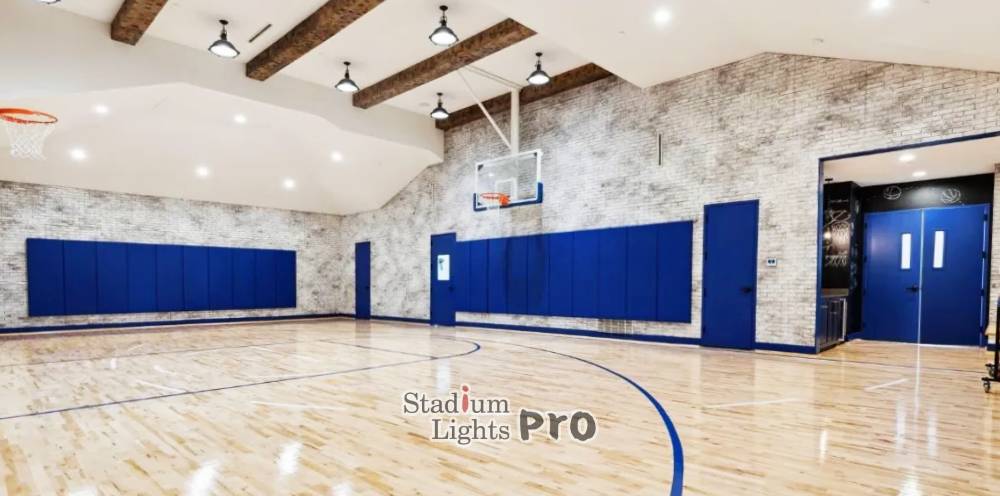
Determining optimal basketball court lighting placement
Importance of strategic lighting placement for even illumination
Strategic outdoor basketball court lighting placement plays a crucial role in achieving even illumination across the playing surface. Here are some key reasons highlighting the importance of strategic lighting placement:
Enhanced visibility
Proper lighting placement ensures that players have clear visibility of the entire basketball court. Even illumination minimizes shadows, dark spots, and glare, enabling players to see the ball, their teammates, and opponents accurately. This improves safety, gameplay accuracy, and overall performance.
Reduced eye fatigue
Uneven lighting or excessive glare can cause eye fatigue and strain for players. By strategically placing lighting fixtures, the light can be evenly distributed, reducing eye strain and allowing players to focus on the game without unnecessary visual distractions.
Consistent gameplay
Even illumination helps maintain consistent lighting conditions throughout the court. This is particularly essential for competitive games, as it ensures fair play and prevents any disadvantage due to uneven lighting or visibility issues in specific areas.
Safety and injury prevention
Adequate and uniform lighting across the court helps prevent accidents and injuries. Uneven lighting can create tripping hazards or make it difficult for players to judge distances accurately, increasing the risk of collisions or missteps. Proper placement of lighting fixtures ensures consistent visibility, reducing the likelihood of accidents.
Spectator experience
Strategic lighting placement also enhances the spectator experience. When the playing surface is evenly illuminated, spectators can clearly see the action and follow the game without any dark or poorly lit areas obstructing their view. This improves the overall enjoyment of the game and provides a better viewing experience for fans.
Aesthetics and ambiance
Proper lighting placement contributes to the overall aesthetics and ambiance of the basketball court. Well-lit courts create a visually appealing environment, showcasing the game and enhancing the overall appeal of the facility, especially during evening or night events.
Consider the angles and heights at which the lights should be installed
The angles and heights at which basketball court lights should be installed are critical factors that affect the quality and evenness of the illumination on the playing surface. Here are some considerations for the angles and heights of basketball court lights:
Mounting height
The mounting height of the lights should be sufficient to avoid obstructions and provide clear visibility across the court. For outdoor basketball courts, a common mounting height range is between 20 to 30 feet (6 to 9 meters). The height may vary depending on the court size, level of play, lighting technology used, and local regulations or standards.
Angle of elevation
The angle of elevation refers to the angle at which the lights are tilted upward from the horizontal plane. The angle should be carefully chosen to minimize shadows and provide uniform illumination across the playing surface. A general guideline is to aim for an angle of elevation between 30 to 45 degrees. The specific angle may vary depending on the court size, lighting technology, and desired lighting distribution.
Beam angle and distribution
The beam angle of the lighting fixtures determines the spread of light on the court. We can select fixtures with appropriate beam angles that match the court dimensions. Narrower beam angles (around 15 to 30 degrees) are suitable for smaller courts, while wider beam angles (around 40 to 60 degrees) are better for larger courts. The goal is to achieve consistent illumination with minimal hotspots or dark areas.
Lighting zones
Dividing the court into lighting zones can help ensure even illumination and enhance visibility. Each lighting zone can have specific lighting fixtures aimed at different areas, such as the playing area, sidelines, and end lines. By adjusting the angles and heights of the fixtures within each zone, it is possible to achieve uniform illumination and minimize shadowing.
Glare control
The positioning of the lights should consider glare control to minimize discomfort for players and spectators. Light fixtures should be shielded or equipped with optics that direct the light downward and reduce direct glare.
Avoid shadows and glare on the playing surface
Here are the key reasons why it is essential to minimize shadows and glare:
Visibility and accuracy
Shadows on the playing surface can obstruct players’ vision and make it challenging to see the ball, other players, and the court markings accurately. By minimizing shadows, players can have clear visibility, allowing them to make precise movements, passes, and shots.
Safety
Shadows can create visual inconsistencies and distort perception, increasing the risk of collisions, tripping, or other accidents on the court. Eliminating or minimizing shadows helps ensure a safe playing environment and reduces the likelihood of player injuries.
Fairness and consistency
Shadows that affect specific areas of the court can create unfair advantages or disadvantages for players. By achieving even illumination, all players have an equal opportunity to perform their best, ensuring fair gameplay and maintaining a level playing field.
Eye comfort
Glare caused by excessive brightness or poorly positioned lighting fixtures can strain the eyes of players and spectators. Glare can lead to discomfort, reduced visual acuity, and eye fatigue. By minimizing glare, players can focus better, react more quickly, and enjoy a more comfortable playing experience.
Aesthetics
Shadows and glare can detract from the overall aesthetics of the basketball court. By achieving uniform and shadow-free illumination, the court’s appearance is enhanced, creating a visually appealing environment for players and spectators.
To avoid shadows and glare on the playing surface, the following measures can be taken:
- Careful positioning and aiming of lighting fixtures to ensure the light is directed downward onto the court.
- Use of fixtures with appropriate optics and shielding to control the light distribution and minimize upward light spillage.
- Consideration of the court’s layout, dimensions, and any obstacles that may create shadows, such as nearby structures or trees.
- Regular maintenance and cleaning of lighting fixtures to prevent dirt or debris from obstructing the light output.
- Utilization of lighting control systems that allow for precise adjustment of light levels and zoning to minimize shadows and optimize lighting distribution.
By paying attention to these factors and taking proactive measures to minimize shadows and glare, the outdoor basketball court can provide optimal visibility, safety, and an enjoyable playing experience for all participants.
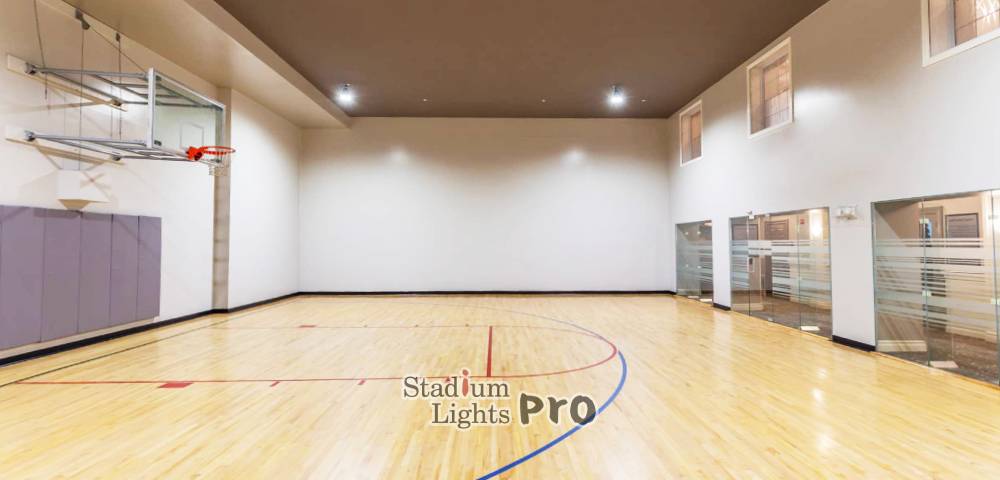
Calculating the required light levels for outdoor basketball court
Calculating the number of lighting fixtures needed for an outdoor basketball court involves considering the court size, desired light levels, and the lighting technology’s characteristics. Here’s a step-by-step guide to help you calculate the number of fixtures required:
Step 1 – Determine the court area
- Measure the length and width of the basketball court to determine its total area.
- Multiply the length by the width to obtain the court’s area in square feet or square meters.
Step 2 – Determine the desired light levels
- Determine the desired light levels for the basketball court based on the level of play and any applicable lighting standards or regulations.
- Light levels are typically measured in foot-candles (fc) or lux. Foot-candles are more commonly used in North America, while lux is the standard unit of measurement in many other countries.
Step 3 – Convert light levels (if necessary)
- If the desired light levels are given in foot-candles and you prefer to work with lux, convert the foot-candle values to lux using the conversion factor of 10.764.
- For example, if the desired light level is 50 foot-candles, it would be equivalent to 538 lux (50 fc * 10.764).
Step 4 – Determine the lighting technology’s light distribution
- Different lighting technologies have different light distribution characteristics.
- Consult the lighting fixture’s specifications or technical data to determine its beam angle and light distribution pattern.
Step 5 – Calculate the illuminance uniformity ratio
- Consider the desired level of uniformity across the basketball court.
- The illuminance uniformity ratio is typically expressed as a percentage, representing the ratio of the minimum light level to the average light level.
- A higher uniformity ratio indicates more even illumination.
- Common uniformity ratios range from 0.4 to 0.8, with higher ratios resulting in more uniform lighting.
Step 6 – Calculate the total illuminance required
- Multiply the desired light levels by the illuminance uniformity ratio to calculate the total illuminance required across the basketball court.
- For example, if you determined that a minimum of 50 lux (538 fc) is required, and you have a uniformity ratio of 0.6, the total illuminance required would be 83 lux (50 lux / 0.6).
Step 7 – Determine the fixture spacing and overlap
- Consider the fixture spacing and overlap to ensure uniform lighting distribution.
- The spacing between fixtures will depend on the lighting technology, beam angle, and desired light levels.
- Consult lighting design guidelines or recommendations specific to the chosen lighting technology.
Step 8 – Calculate the number of fixtures
- Divide the total illuminance required by the illuminance delivered by each fixture to calculate the number of fixtures needed.
- Adjust the number of fixtures based on the spacing and overlap determined in the previous step.
Step 9 – Consider practical factors
Consider practical factors such as available fixture options, budget constraints, and any local regulations or guidelines that may impact the final fixture selection and placement.
Maintenance and operation considerations
Importance of regular maintenance for optimal performance and longevity of the lighting system
Performance and visibility
Regular maintenance helps maintain the lighting system’s performance, ensuring consistent and appropriate illumination levels across the court. By addressing issues such as dimming lights, flickering, or uneven lighting distribution, maintenance activities like cleaning, repositioning fixtures, or replacing faulty components can help optimize visibility and enhance the overall quality of the lighting.
Safety
Well-maintained lighting systems contribute to a safer playing environment. By promptly addressing any lighting issues, such as burned-out bulbs or damaged fixtures, potential hazards or accidents due to poor visibility can be minimized. Adequate lighting also helps players and spectators navigate the surroundings, reducing the risk of trips, falls, or collisions.
Energy efficiency
Regular maintenance allows for the identification and rectification of energy inefficiencies within the lighting system. By ensuring that fixtures are clean, properly aligned, and functioning optimally, energy wastage can be minimized. This leads to cost savings and reduces the environmental impact associated with excessive energy consumption.
Longevity and cost savings
Effective maintenance practices prolong the lifespan of the lighting system. Regular inspections, cleaning, and timely replacement of worn-out components help prevent premature failures, ensuring that the lighting system operates at its optimal capacity for an extended period. This reduces the need for frequent replacements and costly repairs, resulting in long-term cost savings.
Compliance with regulations
Regular maintenance helps ensure that the basketball court lighting system complies with local regulations and lighting standards. Compliance with these guidelines is necessary not only for safety but also to avoid any penalties or legal issues.
Aesthetics and user experience
Well-maintained lighting enhances the aesthetics of the basketball court, contributing to a positive user experience for players and spectators. When the lighting system is clean, functional, and properly aligned, it creates a visually pleasing atmosphere, adding to the overall enjoyment of the game.
To maintain the basketball court lighting system effectively, consider implementing the following maintenance practices:
- Regular cleaning of fixtures and lenses to remove dust, dirt, or debris that can affect light output.
- Inspection of electrical connections, wiring, and control systems to identify any potential issues.
Periodic relamping or replacement of bulbs or fixtures as per manufacturer recommendations or when light output depreciates significantly. - Verification of fixture alignment and beam angles to ensure optimal light distribution.
- Monitoring and adjustment of lighting controls or timers to optimize energy usage and ensure appropriate lighting levels for different usage scenarios.
- Documentation of maintenance activities, including schedules, replacements, and repairs, to maintain a comprehensive maintenance record.
Cost considerations of outdoor basketball court lighting
The initial cost of purchasing and installing an outdoor basketball court lighting system can vary depending on several factors, including the size of the court, desired light levels, lighting technology chosen, and the complexity of the installation. Here are some cost considerations:
Lighting fixtures
The cost of lighting fixtures will depend on factors such as the type of technology (LED, metal halide, etc.), wattage, beam angle, and brand. LED fixtures tend to have higher upfront costs but offer better energy efficiency and longevity compared to traditional technologies like metal halide or fluorescent.
Number of fixtures
The number of fixtures required will depend on factors such as court size, desired light levels, and lighting design. Larger courts or higher light level requirements will generally require more fixtures, which can impact the overall cost.
Mounting infrastructure
The cost of mounting infrastructure, such as poles, brackets, and wiring, should be taken into account. The height and number of poles required will depend on the court size, lighting technology, and specific project requirements.
Electrical work
Depending on the existing electrical infrastructure and the lighting system’s power requirements, there may be a need for electrical work, such as wiring, circuit installation, or upgrades. The cost of electrical work can vary based on the complexity of the installation and local labor rates.
Installation labor
The cost of professional installation labor should be considered. Hiring experienced electricians or lighting technicians to properly install and aim the fixtures is crucial for optimal performance and safety. Installation costs can vary depending on the complexity of the project and the labor rates in your area.
Control system
If you choose to incorporate a lighting control system for energy management or scheduling purposes, there will be additional costs associated with the control hardware, software, and installation.
Cost estimation
While it is challenging to provide precise cost figures without specific project details, here is a general range of costs based on typical scenarios:
Small recreational system
- Court size: Small or half-court
- Light levels: Basic recreational levels
- Lighting technology: LED or metal halide
- Estimated cost range: $5,000 to $15,000
Medium-sized amateur system
- Court size: Standard full-court
- Light levels: Moderate amateur levels
- Lighting technology: LED or metal halide
- Estimated cost range: $15,000 to $30,000
Large professional system
- Court size: Full-sized professional court
- Light levels: High professional levels
- Lighting technology: High-performance LED
- Additional features: Lighting controls, advanced optics
- Estimated cost range: $30,000 to $100,000 or more
Please note that the above cost ranges are approximate and can vary significantly based on factors such as geographical location, specific project requirements, chosen lighting technology, quality of fixtures, installation complexity, and any additional features or customization desired.
Conclusion
Proper lighting is essential for outdoor basketball courts to ensure safety, visibility, and an optimal playing experience.We discussed the importance of lighting and highlighted the benefits of well-lit courts, such as enhanced safety and better visibility.
Assessing the lighting requirements involves considering factors such as court size, level of play, and local regulations. It is crucial to determine the desired light levels, lighting technology, and the number of fixtures needed to achieve uniform illumination.
If you require additional information or have any inquiries regarding outdoor basketball court lighting, please do not hesitate to reach out to us. We are here to assist you and provide the necessary guidance and support you need.
Our team is well-versed in outdoor basketball court lighting solutions and can offer expert advice tailored to your specific requirements. Whether you have questions about lighting technologies, design considerations, installation processes, or maintenance, we are here to provide you with the information you need to make informed decisions.
We understand the importance of proper lighting for outdoor basketball courts, and we are dedicated to ensuring that you have the best possible lighting solution for your court. Our knowledgeable professionals will be happy to address your concerns, provide detailed explanations, and offer personalized recommendations based on your unique circumstances.
Please feel free to contact us at your convenience. We look forward to assisting you and being a valuable resource for all your outdoor basketball court lighting needs.

